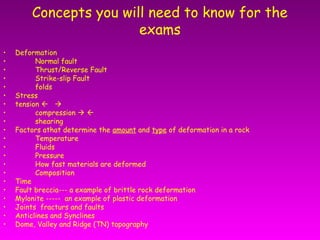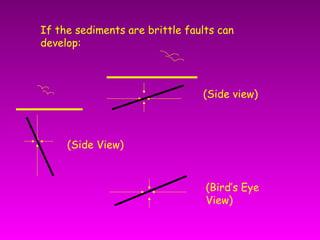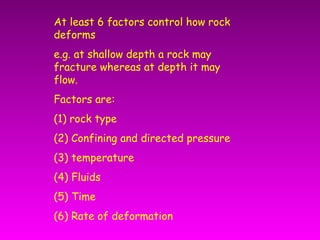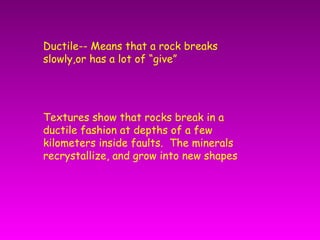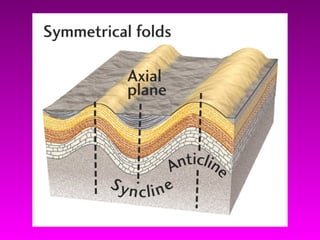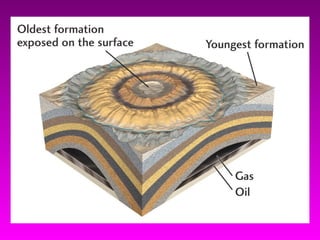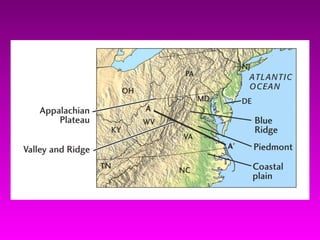Folds& fults
- 1. Folds, Faults and Other Records of Rock Deformation Ch.11 Grotzinger, Jordan Press & Siever
- 2. Concepts you will need to know for the exams • Deformation • Normal fault • Thrust/Reverse Fault • Strike-slip Fault • folds • Stress • tension • compression • shearing • Factors athat determine the amount and type of deformation in a rock • Temperature • Fluids • Pressure • How fast materials are deformed • Composition • Time • Fault breccia--- a example of brittle rock deformation • Mylonite ----- an example of plastic deformation • Joints fracturs and faults • Anticlines and Synclines • Dome, Valley and Ridge (TN) topography
- 3. A fold is a bend in a rock… But, how can this be???? “Inequality is the cause of all local movements” LEONARDO DA VINCI (1452-1519)
- 5. A fault is a break in a rock across which there is observable movement. When the break occurred an earthquake was generated, whether or not anyone was there to detect it. Sometimes faults die at depth and do not break the surface. Sometimes they do such as for the Armenia 1988 earthquake.
- 8. Directed pressure (cf. confining) in the earth leads to deformation if it is great enough. Rocks deform under three orientations for the directed pressure or STRESS.
- 9. The directed stress can have three orientations with respect to vertical: (Side view) (Side View) (Bird’s Eye View)
- 10. If the sediments are “soft” and folds develop: (Side view) (Side View) (Bird’s Eye View) H I G H S L O W S H I G H S L O W S L O W S
- 14. If the sediments are brittle faults can develop: (Side view) (Side View) (Bird’s Eye View)
- 15. If the sediments are brittle faults can develop: (Side view) (Side View) (Bird’s Eye View)
- 17. What is the direction of directed pressure? How many orientations of faults can be generated for the same directed pressure direction??
- 19. What is your opinion? 1. True 2. False
- 20. If the sediments two possible orientations for faults can develop: (Side view) (Side View) (Bird’s Eye View)
- 21. At least 6 factors control how rock deforms e.g. at shallow depth a rock may fracture whereas at depth it may flow. Factors are: (1) rock type (2) Confining and directed pressure (3) temperature (4) Fluids (5) Time (6) Rate of deformation
- 22. Brittle: Means a rock breaks quickly into sharp pieces, e.g. glass at room temperature Textures show that rocks break in a brittle fashion at shallow depths inside faults (I.e. fault breccia, fault flour)
- 24. Ductile-- Means that a rock breaks slowly,or has a lot of “give” Textures show that rocks break in a ductile fashion at depths of a few kilometers inside faults. The minerals recrystallize, and grow into new shapes
- 26. Joints are also fractures, but which do not show clear movement of blocks across them. ( Remember: Faults are also fractures but WITH movement across the fractures)
- 28. Different types of faults imply different directions of shortening and lengthening and can be used to imply different types of plate margin settings:


